Emphysema DefinitionEmphysema is also known as pulmonary emphysema. It is common respiratory condition characterized by air-filled holes (pneumatosis) in the lungs, which can vary in size and can also be quite large. The breakdown of alveolar walls and the replacement of the spongy lung parenchyma forms the gaps. This reduces the overall alveolar space available for gas exchange, reducing blood oxygen supply. Emphysema commonly affects people in their forties or fifties since it takes time to develop due to the impact of tobacco smoking and other risk factors. Alpha-1 antitrypsin insufficiency is a hereditary risk factor that may cause the illness to manifest emphysema sooner. 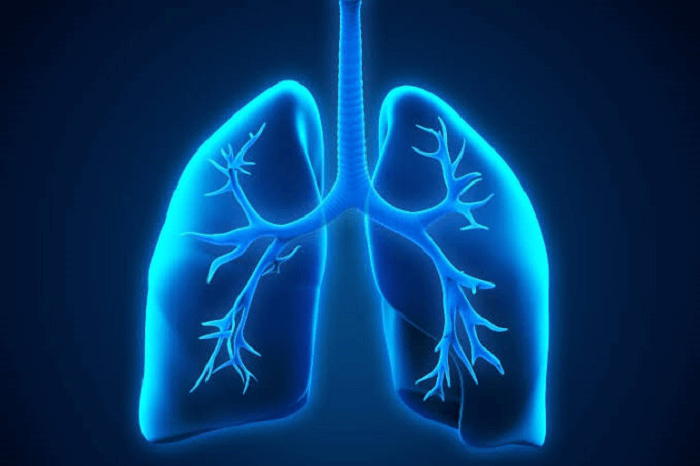
When there is severe airflow limitation then emphysema is a main category of chronic obstructive pulmonary disease (COPD). COPD is a fatal lung disease characterized by chronic breathing problems and insufficient airflow. Emphysema on a CT lung scan increases the risk of death in cigarette users even in the absence of COPD. In 2016, there were 6,977 deaths from emphysema in the United States, accounting for 2.2 deaths per 100,000 people. It is responsible about 5% of deaths around the world. A possibly cumulative harmful effect may be a factor in the development of emphysema and spontaneous pneumothorax, according to a 2018 review of research on the implications of tobacco and cannabis smoking. Only the initial two kinds of emphysema - centrilobular and panlobular - are associated with considerable airflow obstruction, with that centrilobular emphysema roughly 20 times more widespread than panlobular emphysema. The only kind connected with smoking is centrilobular emphysema. 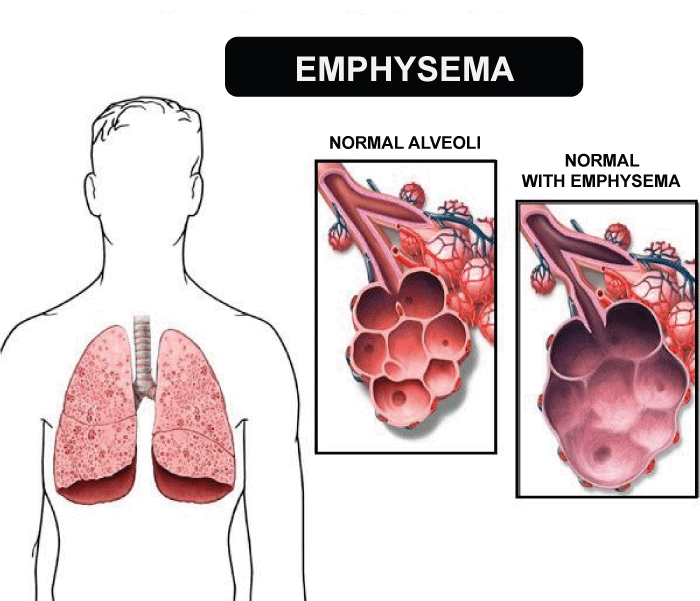
Emphysema is frequently associated with osteoporosis. Systemic corticosteroids are a major risk factor for osteoporosis during exacerbations, and their continuous use is prevented. Emphysema typically develops after a long period of smoking. Yet, there are additional causes of emphysema. They include:
Signs and Symptoms of EmphysemaEmphysema is a lower respiratory tract respiratory illness. It is often caused by tobacco smoking. However, it also affects large number of people who do not smoke or who have never smoked. Emphysema is a major risk factor for lung cancer, and it worsens with smoking. Symptoms of early emphysema might vary from person to person. Coughing (either with or without sputum), wheezing, fast breathing rate, shortness of breath, and chest tightness are all symptoms. There can also be several cold and flu cases because of emphysema. Anxiety, depression, exhaustion, lack of sleep, and weight loss are all possible symptoms. Because these symptoms might also be associated with other lung illnesses or health issues, emphysema is frequently misdiagnosed. 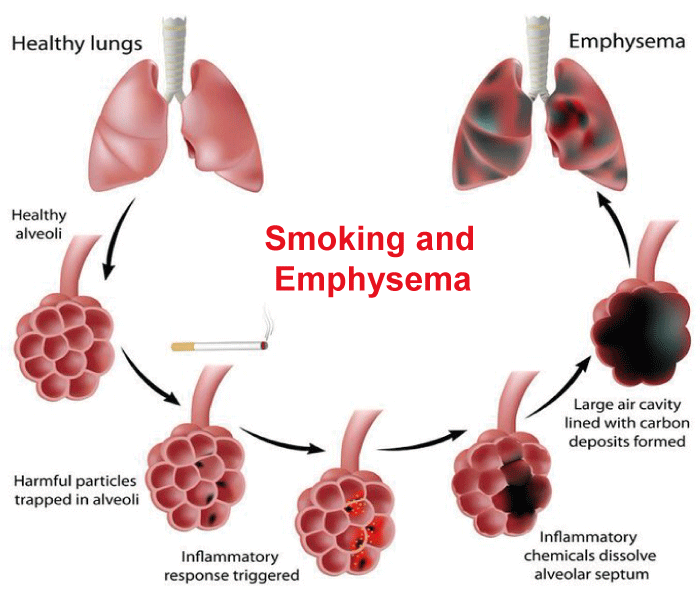
Emphysema related shortness of breath can worsen with time and progress to chronic obstructive pulmonary disease. A larger number of alveolar macrophages found in bronchoalveolar lavage (BAL) samples from smokers is a marker of emphysema. The number of smokers who have emphysema can be four to six times greater than that of non-smokers. Ignoring emphysema symptoms and delaying to seek the treatment might result in further lung damage as well as worsening of the illness. Emphysema is a progressive condition, which means it worsens with time. It can develop to consequences such as respiratory infections, pulmonary hypertension, and cardiac issues if not properly managed. Emphysema can be life-threatening in extreme situations. As a result, if you are suffering symptoms such as shortness of breath, persistent cough, wheezing, or chest tightness, it is essential to get medical support. History of EmphysemaEmphysema and chronic bronchitis were formally defined in 1959 in a CIBA guest symposium, then in 1962 at an American Thoracic Society Committee on Diagnostic Standards meeting. The term "emphysema" is taken from the Ancient Greek ???????? "inflation, swelling" (referring to a lung expanded by air-filled spaces), which is derived from ??????? emphysao "to blow in, to inflate," which is made up of ?? en, which means "in," and ???? physa, which means "wind, blast."Ren� Laennec, the physician who discovered the stethoscope, used the term emphysema to describe lungs that did not collapse when he exposed the chest during an autopsy. In his book A Treatise on the Diseases of the Chest and Mediate Auscultation (1837), He noticed they did not collapse as expected since they were full of air and mucus-filled airways. Early reports of possible emphysema include T. Bonet's description of "voluminous lungs" in 1679 and Giovanni Morgagni's description of lungs that were "turgid particularly from air" in 1769. Ruysh created the drawings of emphysema in 1721. These were followed by Matthew Baillie's illustrations and descriptions of the destructive nature of the condition in 1789. Types in EmphysemaThere are four types of emphysema, three of which are associated with the anatomy of lung lobules but are not associated with fibrosis those are centrilobular emphysema, panlobular or panacinar emphysema, and para septal or distal acinar emphysema Although fibrosis is not a normal component of these subtypes, lung fibrosis may occur with end-stage emphysema repair procedures. The fourth type is para cicatricial or irregular emphysema which is associated with fibrosis and includes the acinus irregularly. 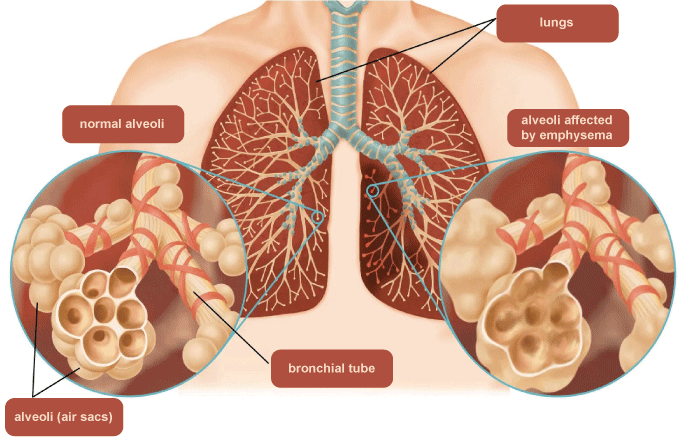
Only the primary two kinds of emphysema - centrilobular and panlobular emphysema are linked with considerable airway obstruction, with centrilobular emphysema being approximately 20 times more widespread than panlobular. The subtypes are detectable on imaging but have not been clinically identified. A few other illnesses are connected to Ritalin lung such as bullous emphysema, concentrated emphysema, and Ritalin emphysema. Some of the more serious sequelae of centrilobular and panlobular emphysema include respiratory failure, respiratory infections, pneumonia, pneumothorax, pulmonary heart disease, interstitial emphysema, and respiratory acidosis. CentrilobularCentrilobular emphysema, also known as centriacinar emphysema is a lung disease affecting the centre of a pulmonary lobule, the area around the terminal bronchiole and the initial respiratory bronchiole which is seen on the area at the tip of the visible pulmonary artery. The most common type of emphysema is centrilobular emphysema which is frequently associated with smoking and chronic bronchitis. The disease progresses from the centrilobular to the per lobular region, leaving the lung parenchyma untouched but the higher lobes of the lungs are usually impacted. PanlobularPanlobular emphysema, also termed panacinar emphysema is a lung disease that affects both the upper and lower lobes. This kind of emphysema has been linked to A1AD (Alpha-1 antitrypsin deficiency) as well as Ritalin lung but not smoking. ParaseptalParaseptal emphysema, also known as distal acinar emphysema, is an emphysematous alteration near a pleural surface or a fissure. In paraseptal emphysema, cystic areas known as blebs or bullae form in only one layer underneath the pleura. This sets it apart from the honeycombing of small cystic areas found in fibrosis which commonly occurs in layers. Airflow obstruction is not related to this kind of emphysema. BullousThe presence of subpleural bullae characterizes bullous emphysema. Bullae can grow and join together to generate huge bullae. They can occupy one-third of a hemithorax by squeezing and displacing the lung parenchyma. The emphysema is now classified as big bullous emphysema sometimes known as vanishing lung syndrome due to the compacted parenchyma. From time to time a bleb or bulla may rupture and induce a pneumothorax. ParacicatricialLarge voids are visible close to fibrosis (scarring) patches in paracicatricial emphysema which is also described as irregular emphysema. Scarring is often the result of silicosis, tuberculosis, granulomatous infection, or pulmonary infarction. It can be difficult to distinguish from pulmonary fibrosis honeycombing. HIV AssociatedEmphysema is a source of sickness in classic lung disorders caused by HIV/AIDS. HIV is a risk factor for emphysema and COPD regardless of smoking status. Roughly 20% of HIV patients have advanced emphysematous variations. This shows that an underlying cause related to HIV may affect emphysema development. HIV-related emphysema develops faster than smoking-related emphysema, emphysema caused by alpha-1 antitrypsin deficiency also manifests earlier. Both disorders are characterised by lower lung damage, showing that the two causes are similar. Alpha-1 AssociatedSome people with alpha-1 antitrypsin deficiency which is the only chronic obstructive pulmonary disease genotype may experience emphysema. This is far more common in HIV-associated emphysema than in other forms. Ritalin LungIntravenous use of methylphenidate often known as Ritalin and widely used as a stimulant drug in treating attention deficit hyperactivity disorder can lead to Ritalin lung, a form of emphysematous change. The mechanism underlying this connection has yet to be well known. Talc is a filler in Ritalin pills that must be broken and dissolved before injection. It has been recommended that talc exposure induces granulomatosis, which leads to alveolar damage. On the other hand, some intravenous medications contain talc, and there is no related emphysematous alteration. CPFE (combined pulmonary fibrosis and emphysema)The syndrome CPFE (combined pulmonary fibrosis and emphysema) is distinguished by upper-lobe emphysema as well as lower-lobe interstitial fibrosis. A CT scan is used to diagnose this. This condition is noticeably affected by the development of pulmonary hypertension. SRIFAnother type of fibrosis that pathologists might identify in emphysematous lungs is smoking-related interstitial fibrosis (SRIF). Unlike CPFE, this fibrosis is usually asymptomatic. Nonetheless, some SRIF patients may present with symptoms and radiologic signs of interstitial lung disease. Congenital lobarCongenital lobar emphysema (CLE), also known as congenital lobar overinflation or infantile lobar emphysema is a birth condition marked by enlarged air spaces in the lungs of newborn infants. It is discovered around the time of birth or within the first six months of life and it affects boys more than girls. The higher lung lobes are more impacted by CLE than the lower lobes, and even the left lung is more severely afflicted than the right lung. CLE is hyperinflation with one or more lung lobes caused by a partial bronchus blockage. 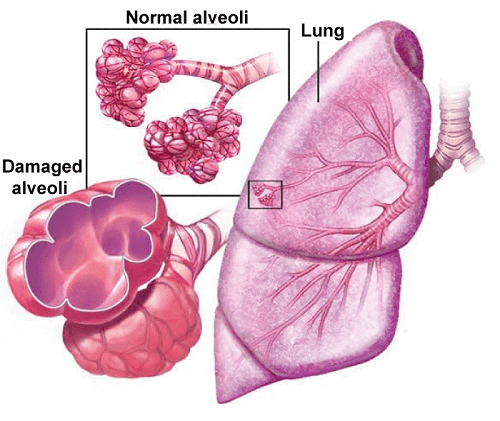
This results in symptoms of pressure on adjacent organs. It has been related to several heart disorders, such as patent ductus arteriosus, ventricular septal defect, atrial septal defect, and tetralogy of Fallot. Although CLE may be caused by abnormal bronchial growth or airway compression by nearby tissues, no reason is found in half of the cases. A CT scan of the lungs is important in determining the structure of the lung lobes and the condition of neighboring lobes in terms of whether they are hypoplastic. Contrast-enhanced CT scans are excellent for detecting vascular abnormalities and mediastinal masses. FocalFocal emphysema is a small area of emphysema in the lung that is larger than the alveoli. It is frequently related to a coal worker's pneumoconiosis. Localized pulmonary emphysema is another term for this condition. Blebs and bullae are other examples of localized emphysema. Its size and wall thickness distinguish them from the other enclosed air pocket, a lung cyst. A bleb or bulla has a smaller and thinner wall than 1 mm. OccupationalVarious occupations have been linked to the development of emphysema due to the inhaling of various gases and particles. Uranium mining, which produces radon gas and particles has been caused for emphysema deaths in the United States, the data in the study included some workers who also smoked. The mining, as well as processing of uranium, were found to be environmentally hazardous. Inhaling coal mine dust, which can cause coal workers pneumoconiosis, is a separate risk factor for the development of emphysema. The coal macule is associated with focal emphysema, progressing to progressive centrilobular emphysema. A type of pan-lobular emphysema develops less frequently. Inhaling silica particles causes silicosis, and the development of large silica nodules is connected to para cicatricial emphysema regardless of the presence of bullae. Ozone-induced EmphysemaAnother pollutant that can harm the respiratory system is ozone. Long-term ozone exposure can cause emphysema. Chronic ozone exposure in mice produces oxidative pathway activation, cell death, and chronic bronchial inflammation with emphysema, mirroring cigarette smoke-induced COPD. The ConclusionTo summarise, emphysema is a chronic respiratory disease defined by the destruction of air sacs (alveoli) in the lungs resulting in decreased flexibility and gas exchange. Shortness of breath, wheezing, coughing, and exhaustion are common symptoms induced by prolonged exposure to irritants such as tobacco smoking or air pollution. People who are ignorant of their emphysema may not seek treatment, leading to insufficient management of their symptoms and perhaps worsening the illness. If emphysema is not identified and dealt with early on, it can progress to complications that need more extensive and expensive healthcare procedures, such as hospitalization, oxygen therapy, or lung transplant. In severe cases, treatment options include lifestyle modifications such as stopping smoking and avoiding air pollution, medicine, oxygen therapy, and surgery. Emphysema is a serious and possibly fatal disease, but with good medication and care, many patients with emphysema can live active and healthy life.
Next TopicGame Definition
|
 For Videos Join Our Youtube Channel: Join Now
For Videos Join Our Youtube Channel: Join Now
Feedback
- Send your Feedback to [email protected]
Help Others, Please Share









